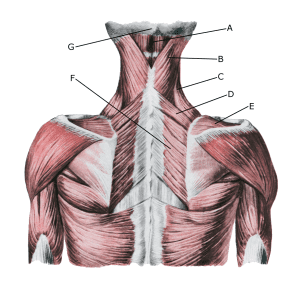Anatomy

Numerous muscles originate and attach around the shoulder-neck.
Deep neck and back muscles from behind:
A. M. semispinalis capitis
B. Mm. splenii capitis et cervicis
C. M. levator scapulae
D. M. rhomboideus minor
E. M. supraspinatus
F. M. rhomboideus major
G. Protuberantia occipitalis externa
Cause
All muscles around the shoulder and neck can become tense and sore and develop sore muscle knots (myositis). The cause of the development of myositis is not known for certain, but while caused by overloading the muscles, possibly with minimal tissue damage leading to localised inflammation, it is known that incorrect posture and repetitive strain can trigger myositis and that myositis can occur secondary to pain conditions elsewhere in the neck and shoulder area.
The most common sites of muscle infiltration are the scapula muscles (M supraspinatus and M infraspinatus, from which pain can radiate down the arm) and the large neck and back muscles (M trapezius, M levator scapulae, M rhomboideus) and the neck muscle (M sternocleido-mastoideus).
Symptoms
Soreness in the muscles with aggravation when the muscle is pressed. Often there is radiation (trigger point) to the arm (from muscle infiltrations around the shoulder blade) and to the head (tension headache with pressure behind the eyes) from muscle infiltrations on the muscle attachments in the back of the head.
Examination
Muscle infiltrations do not usually require further investigation, but if discomfort persists, other triggers should be ruled out.
Treatment
If possible, the triggering cause should be removed or treated. The treatment of muscle infiltrations mainly involves stretching and increasing strength training.
Complications
If the progress is not smooth, you should consider whether the diagnosis is correct or if there are complications.
In particular, the following should be considered:
- Rupture of the upper shoulder blade muscle
- Inflammation of the tendon sheath of the upper shoulder blade muscle
- Tendinitis of the biceps muscle
- Luxation of the joint between the shpulder blade and the collarbone
- Luxation of the shoulder joint
- Frozen shoulder
- Meniscus lesion in the shoulder
- Nerve entrapment on the back of the shoulder blade
- Slipped disc in the nape of the neck
